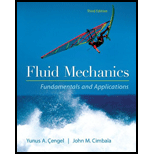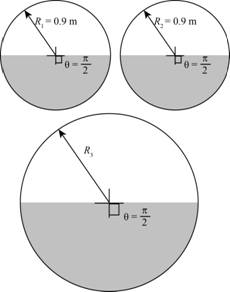
Concept explainers
The diameter of the third channel.
Answer to Problem 59P
The diameter of the channel 3 is
Explanation of Solution
Given Information:
The figure below represents the cross -section of three channels.

Figure-(1)
The diameter of channel 1 is
Write the expression for flow rate from channel 1 and channel 2.
Here, the manning's coefficient for channel 1 is
Write the expression for flow rate through the channel 3.
Here, the manning's coefficient for channel 3 is
Write the expression for the cross sectional flow area of channel1.
Here, the radius of the channel 1 is
Write the expression for the cross sectional flow area of channel 2.
Here, the radius of the channel 2 is
Write the expression for the cross sectional flow area of channel 3.
Here, the radius of the channel 3 is
Write the expression to calculate the wetted perimeter of the channel 1.
Write the expression to calculate the wetted perimeter of the channel 2.
Write the expression to calculate the wetted perimeter of the channel 3.
Write the expression to calculate the hydraulic radius of channel 1.
Write the expression to calculate the hydraulic radius of channel 2.
Write the expression to calculate the hydraulic radius of channel 3.
Write the expression to calculate the diameter of the channel 3.
Calculation:
Substitute
Substitute
Substitute
Substitute
Substitute
Substitute
Substitute
Refer to Table (13.1), "Mean values of the Manning Coefficient for water flow in open channels" to obtain the value of
Substitute
Substitute
Substitute
Conclusion:
The diameter of the channel 3 is
Want to see more full solutions like this?
Chapter 13 Solutions
Fluid Mechanics Fundamentals And Applications
- Water flows through a 2-m-wide rectangular channel with an average velocity of 5 m/s. If the flow is critical, determine the flow rate of water.arrow_forwardThe flow rate of water in a 6-m-wide rectangular channel is to be measured using a 1.3-m-high sharp-crested rectangular weir that spans across the channel. If the head above the weir crest is 0.70 m upstream from the weir, determine the flow rate of water.arrow_forwardWater at 20°C flows at a depth of 0.4 m with an average velocity of 4 m/s in a rectangular channel. Determine the specific energy of the water and whether the flow is subcritical or supercritical.arrow_forward
- Water is flowing uniformly in a finished-concrete channel of trapezoidal cross section with a bottom width of 0.8 m, trapezoid angle of 50°, and a bottom angle of 0.4°. If the flow depth is measured to be 0.52 m, determine the flow rate of water through the channel.arrow_forwardThe flow rate of water flowing in a 5-m-wide channel is to be measured with a sharp-crested triangular weir 0.5 m above the channel bottom with a notch angle of 80°. If the flow depth upstream from the weir is 1.5 m, determine the flow rate of water through the channel. Take the weir discharge coefficient to be 0.60.arrow_forwardA 3-ft-diameter semicircular channel made of unfinished concrete is to transport water to a distance of 1 miuniformly. If the flow rate is to reach 90 ft3/s when the channel is full, determine the minimum elevation difference across the channel.arrow_forward
- After heavy rain, water flows on a concrete surface at an average velocity of 1.3 m/s. If the water depth is 2 cm, determine whether the flow is subcritical or supercritical.arrow_forwardThe flow depth and velocity of water after undergoing a hydraulic jump are measured to be 1.1 m and 1.75 m/s, respectively. Determine the flow depth and velocity before the jump, and the fraction of mechanical energy dissipated.arrow_forwardDuring steady and uniform flow through an open channel of rectangular cross section, a person claims that the specific energy of the fluid remains constant. A second person claims that the specific energy decreases along the flow because of the frictional effects and thus head loss. With which person do you agree? Explain.arrow_forward
- Given the average flow velocity and the flow depth, explain how you would determine if the flow in open channels is tranquil, critical, or rapid.arrow_forwardHow is the specific energy of a fluid flowing in an open channel defined in terms of heads?arrow_forwardWhat is critical depth in open-channel flow? For a given average flow velocity, how is it determined?arrow_forward
 Elements Of ElectromagneticsMechanical EngineeringISBN:9780190698614Author:Sadiku, Matthew N. O.Publisher:Oxford University Press
Elements Of ElectromagneticsMechanical EngineeringISBN:9780190698614Author:Sadiku, Matthew N. O.Publisher:Oxford University Press Mechanics of Materials (10th Edition)Mechanical EngineeringISBN:9780134319650Author:Russell C. HibbelerPublisher:PEARSON
Mechanics of Materials (10th Edition)Mechanical EngineeringISBN:9780134319650Author:Russell C. HibbelerPublisher:PEARSON Thermodynamics: An Engineering ApproachMechanical EngineeringISBN:9781259822674Author:Yunus A. Cengel Dr., Michael A. BolesPublisher:McGraw-Hill Education
Thermodynamics: An Engineering ApproachMechanical EngineeringISBN:9781259822674Author:Yunus A. Cengel Dr., Michael A. BolesPublisher:McGraw-Hill Education Control Systems EngineeringMechanical EngineeringISBN:9781118170519Author:Norman S. NisePublisher:WILEY
Control Systems EngineeringMechanical EngineeringISBN:9781118170519Author:Norman S. NisePublisher:WILEY Mechanics of Materials (MindTap Course List)Mechanical EngineeringISBN:9781337093347Author:Barry J. Goodno, James M. GerePublisher:Cengage Learning
Mechanics of Materials (MindTap Course List)Mechanical EngineeringISBN:9781337093347Author:Barry J. Goodno, James M. GerePublisher:Cengage Learning Engineering Mechanics: StaticsMechanical EngineeringISBN:9781118807330Author:James L. Meriam, L. G. Kraige, J. N. BoltonPublisher:WILEY
Engineering Mechanics: StaticsMechanical EngineeringISBN:9781118807330Author:James L. Meriam, L. G. Kraige, J. N. BoltonPublisher:WILEY





